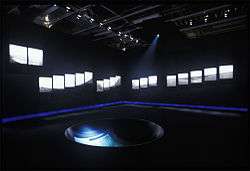Taku Aramasa
Taku Aramasa[1] (新正 卓, Aramasa Taku, born 15 August 1936) is a Japanese photographer.

Born in Tokyo, Aramasa moved with his family to Manchukuo in 1940. In 1948 he moved to Sakata, Yamagata. He graduated from Musashino Art School (武蔵野美術学校, Musashino Bijutsu Gakkō) (now Musashino Art University) in 1960, and set up a design company in which he was an art director, but became a freelance in 1970. He worked as a fashion photographer in Paris from 1973 to 1976. In 1980 he met his parents, from whom he had been separated, and started work on a photographic contribution to the effort of reuniting Japanese war orphans and their biological parents. This work branched into the photography of people of Japanese descent in Hawai'i and South America.[2]
A Portrait of Japanese Immigrants to South America won the Domon Ken Award in 1986; Aramasa subsequently won various other awards.[2]
Aramasa has taught at Musashino Art University from 1993.[2]
Exhibitions
- "A Portrait of Japanese Immigrants to South America," Yurakucho Marion, Tokyo, 1986
- "A Portrait of Japanese Immigrants to South America," Hiroshima and Osaka, Japan, 1987
- "Taku Aramasa Photographs-The 80th Anniversary of Japanese Immigration to Brazil," São Paulo Museum of Modern Art, São Paulo, 1988
- "Family, Commemorative Exhibition of 'Who Am I'," Nikon Salon, Tokyo and Osaka, 1990
- "Who Am I?- War Orphans Left in China," Tokyo Metropolitan Art Gallery, Tokyo, 1991
- "Who Am I?- War Orphans Left in China," Hiroshima and Fukuoka, Japan, 1992
- "Taku Aramasa Photographs: Portraits of Native America," Yuraku-cho Art Forum, Tokyo, Hakata, Nara and Takaoka, Japan, 1994
- "Silent Land-Prison Camps in Siberia," Sinjuku Park Tower Gallery 1, Tokyo, 1995
- "Manchuria/Siberia," Kawasaki City Museum, Kawasaki, Japan, 1996
- "Silent Land-Prison Camps in Siberia," Tokyo Metropolitan Museum of Photography, Tokyo, 1997
- "Aramasa Taku Photographs-America/Promised Land," Mitsumura Art Plaza, Tokyo, 2000
- "11+1 Photographs," Musashino Art University, Department of Imaging Arts 10th Anniversary, Mitsumura Art Plaza, Tokyo, 2000
- "Aramasa Taku Photographs: Portraits of Japanese Immigrants," Polaroid Gallery, Tokyo, 2001
- "Only Skin Deep-Changing vision of the American self," International Center of Photography, New York, NY
- "Aramasa Taku-Sakura," Stephen Wirtz Gallery, San Francisco California, 2005
- "Aramasa Taku Photographs-Apocalypse," Museum of Musashino Art University, Tokyo, 2006
- "Aramasa Taku Photographs-America/promised Land" (platinum prints) Gallery Out of Place, Nara Japan, 2008
- "Aramasa Sakura," Nikon Salon, Tokyo and Osaka, 2008
- 「frame & vision」 -blessing in forest- ARAMASA Taku Solo Exhibition Tokyo Gallery+BTAP, 2009
- "ARAMASA Taku Photographs 2011"(Na2 Platina print) One Men Show, OUT of PLACE, Nara, 2011
- "ARAMASA Taku 2012 -HRIZON-" One Men Show, Tokyo Publishing House,Tokyo, 2012
- "ARAMASA Taku 2014 -HRIZON-" One Men Show, Annely Juda Fine Art, London, 2014
Awards
- 28th New Artist of the Year Award, Japan Photography Association, 1978
- Grand Prize (Public Poster) at the 1st International Triennale Toyama, 1985
- the 5th Domon Ken Award, 1986
- the 10th Higashikawa Award, 1994
- the 46th Artist of the Year Award, Japan Photography Association, 1996
Collections
- Center for Creative Photography, University of Arizona, Arizona
- Domon Ken Memorial Hall, Sakata, Japan
- Higashikawa Museum, Higashikawa-cho, Hokkaido, Japan
- São Paulo Museum, São Paulo, Brazil
- History Museum of Japanese Immigrants, São Paulo, Brazil
- International Center of Photography, New York, New York
- Osaka Human Rights History Museum, Osaka, Japan
- San Francisco Museum of Modern Art, San Francisco, California
- History Museum of Japanese Immigrants, San Jose, California
- Tokyo Metropolitan Museum of Photography, Tokyo, Japan[3]
- Stephen Wirtz Gallery, San Francisco, California
- Gallery Out of Place, Nara, Japan
- Museum of Musashino Art University, Tokyo, Japan
Books
Books by Aramasa
- Gyakkō sango shō (逆光サンゴ礁). Tokyo: Bunka Shuppankyoku, 1974.
- Aramasa Taku shashinshū (新正卓写真集). Tokyo: 北斗企画.
- 3. Anita Russell. 1977.
- 4. Carnaval. 1979.
- Carnaval: Aramassa e os anjos. Tokyo: Canon, 1979.
- To My Angels. 2nd ed. Tokyo: Zenkoku Kajo Hōrei Shuppan, 1983. ISBN 4-421-01526-1.
- Haruka naru sokoku (遥かなる祖国) / A Portrait of Japanese Immigrants to South America. Tokyo: Asahi Shinbunsha, 1985. ISBN 4-02-255402-9. Text in Japanese and English (English translation by Lora Sharnoff).
- Who Am I? War Orphans Left in China. Who Am I? Publishing Committee. 1990.
- Shūchō no keifu (酋長の系譜) / Portraits of Native America. Tokyo: Kōdansha, 1993. ISBN 4-06-206731-5.
- Monchiku no daichi / Shiberia (沈黙の大地/シベリア) / The Silent Land: Prison Camps in Siberia. Tokyo: Chikuma Shobō, 1995. ISBN 4-480-87274-4.
- Yakusoku no daichi / Amerika (約束の大地/アメリカ) / America / Promised Land. Tokyo: Misuzu Shobō, 2000. ISBN 4-622-04422-6. Text in Japanese and English.
- Mokushi (黙示). Musashino, Tokyo: Musashino Daigaku Shuppankyoku, 2006. ISBN 4-901631-73-X.
- Aramasa Taku Photographs-Apocalypse. Museum Musashino Art University, 2006.
- Aramasa Taku Photographs- Apocalypse. Museum of Musashino Art University, 2007. E-book.
- ARAMASA Taku Photographs -ARAMASA SAKURA- in black box / in black room- at one's 1/1, 2010
- "ARAMASA Taku 2014" HORIZON Catalogue© -Annely Juda Fine Art- London, 2014
Other books showing Aramasa's work
- (in Japanese) Nihon nūdo meisakushū (日本ヌード名作集, Japanese nudes). Camera Mainichi bessatsu. Tokyo: Mainichi Shinbunsha, 1982. Pp. 262–3 show a pair of photographs by Aramasa.
Notes
- Aramasa sometimes writes his name "Aramassa" (in roman script and with two "s"es), even in contexts for Japanese.
- Niwa Harumi (丹羽晴美), "Aramasa Taku", Nihon shashinka jiten (日本写真家事典) / 328 Outstanding Japanese Photographers (Kyoto: Tankōsha, 2000; ISBN 4-473-01750-8), p.28. In Japanese only, despite the English-language alternative title of the book.
- Note Aramasa's inclusion within Nihon shashinka jiten / 328 Outstanding Japanese Photographers, a companion to the gallery.